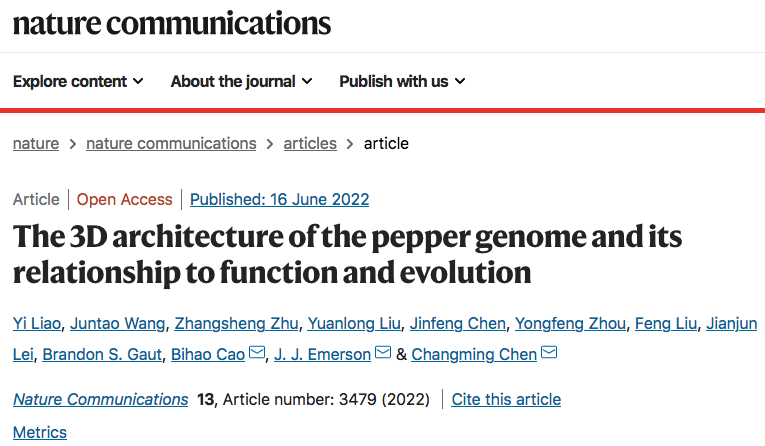
The School of Horticulture, South China Agricultural University published a research paper in Nature Communications, revealing the relationship between the three-dimensional chromatin structure of pepper and genome function and evolution
Chili peppers are one of the most widely grown vegetables in the world and an important seasoning crop. my country's pepper production and consumption ranks first in the world, with a planting area of more than 30 million mu and an output of more than 40 million tons. The annual output value of pepper and its related products is nearly 90 billion. It is the largest vegetable crop in my country. Capsicum is rich in germplasm resources and genetically diverse. There are 5 conventional cultivated species and more than 30 wild species of Capsicum genus have been reported. Its genome is huge (more than 3G) and its structure is complex. The research on pepper genomics is beneficial to the utilization of its germplasm resources and molecular design breeding.
On June 16, 2022, the School of Horticulture, South China Agricultural University published a paper entitled The 3D architecture of the pepper genome and its relationship to function and evolution in the famous academic journal Nature Communications (5yearIF=15.8, District 1 of the Chinese Academy of Sciences, TOP Journal). research paper. This paper uses the excellent pepper inbred line No. 59 cultivated by the pepper research group of South China Agricultural University as the material, and reports the three-generation splicing reference genome of pepper with high quality chromosomes for the first time. By integrating high-resolution Hi-C maps with epigenetic, transcriptomic, and genetic variation data, the basic features of its three-dimensional genome structure and its relationship with genome function and evolution were explored. Although the pepper genome has topologically associating domains (TADs) similar to mammals, its formation and function are not exactly the same. Their borders are hotspots of chromosomal rearrangements, and the sequences in this region are highly conserved, suggesting that their structural integrity is beneficial for genome function. We also demonstrate that although chromatin conformation can broadly predict quantitative differences in transcription, it does not directly explain differential gene expression across tissues. In conclusion, the three-dimensional structure of pepper chromatin is mainly driven by heterochromatin folding mediated by the transcription factory model, and this structure is potentially functional and may be generally applicable to other large plant genomes.

At present, the pepper research group of the School of Horticulture has collected and created more than 1,500 pepper germplasm resources. The high-quality third-generation genome assembly and three-dimensional genome structure analysis obtained in this paper are important agronomic traits of pepper (capsaicin, etc.) and the formation mechanism of heterosis. Research and molecular design breeding provide important theoretical and data support. And it has important reference value for the subsequent computational modeling of plant three-dimensional genome and the development of genetic engineering technology.
The School of Horticulture, South China Agricultural University is the first unit to complete the thesis (Key Laboratory of Horticultural Crop Biology and Germplasm Creation in South China, Ministry of Agriculture and Rural Affairs), and Liao Yi (Ph.D., now University of California, USA) has graduated from the research group of Professor Chen Riyuan of the School of Horticulture. Co-first authors of the paper, Associate Professor Chen Changming and Professor Cao Bihao from the School of Horticulture and J. J. Emerson from the University of California, Irvine The associate professor is the co-corresponding author of the paper. Professor Lei Jianjun and Associate Professor Zhu Zhangsheng from the School of Horticulture gave guidance and support to the experiments and materials related to the thesis. This research was also supported by the internationally renowned plant genome evolutionary geneticist, Prof. Brandon S. Gaut, University of California, Irvine; Prof. Chen Jinfeng, Institute of Zoology, Chinese Academy of Sciences; Prof. Zhou Yongfeng, Shenzhen Institute of Genomics, Chinese Academy of Agricultural Sciences; Dr. Liu Yuanlong, School of Computer Science, University of Lausanne, Switzerland; Academic support from Dr. Hongru Wang from Berkeley, Dr. Shujun Ou from Johns Hopkins University, and Researcher Feng Liu from Hunan Agricultural University. The research was funded by the National Natural Science Foundation of China, the National Key R&D Program, and the Natural Science Foundation of Guangdong Province.
Paper link:
https://www.nature.com/articles/s41467-022-31112-x


